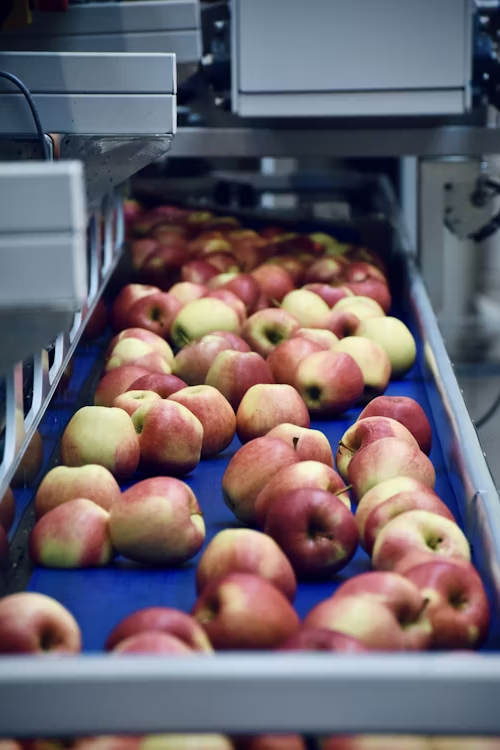As we already know, conveyors are essential components of modern material handling systems. They are widely utilized in a variety of industries for efficient and cost-effective cargo transportation. Besides, such mechanical devices consist of a continuous loop of material, usually a belt, that transports objects from one location to another.
Moving further, they can handle a wide range of materials, from bulk commodities to fragile products, and are essential in industries including manufacturing, mining, shipping, and retail. Ultimately, belt conveyors are a key component of automated systems due to their simplicity and versatility, which increase productivity and operational efficiency.

What is a Conveyor Belt System?
A conveyor belt system is a fast and effective mechanical handling device that transports materials from one location to another. Conveyor systems come in various configurations, but they commonly feature a frame that supports a set of wheels, conveyor rollers, or a belt. Materials are placed on top and moved around. A conveyor belt can be propelled manually, by gravity, or, more typically, with a motor. There are numerous types of conveyor belt systems, each designed to complete a certain duty.
Moving large goods takes longer, costs more, and raises the risk of personal damage. Industrial belt conveyor systems are speedier at transferring things from one location to another. They can move goods from one floor to another with ease. The automatic unloading of items using conveyor belts eliminates the requirement for a person to wait at the end of the line to offload the products.
How do conveyor belts work?
In a conventional conveyor belt system, a belt forms a closed loop that spans two or more pulleys. This allows it to revolve continuously. One of the pulleys (the drive pulley) transfers objects from one location to another. While standard conveyor belt systems are straight, some units must make turns to carry the product to its destination. In some circumstances, cone-shaped wheels or rotors are employed to keep the belt from getting tangled while making a turn.
Common Conveyor System Parts
Conveyor systems require specific components to function effectively. These components will change based on the product being moved and how the system is operated. However, every industrial conveyor system consists of three major components:
1. Belt Support
This ensures that the belt runs smoothly. The support unit must be sturdy; otherwise, the belt may droop when you place a heavy object on it, resulting in slower operation and reduced efficiency. Proper belt tension keeps the belt taut and the system functioning efficiently.
2. Pulley
This external component regulates the belt’s movement. The working idea of this system is that each unit has at least two pulleys. The first is powered, while the second is idle. Complex conveyor systems may have multiple rotors along the frame.
3. Drive Units
This unit includes a counter bearing to keep the pieces moving efficiently. It enables the belt to move into reverse and handle the frequent changes in direction that some systems require. Manually driven conveyor systems still have a driving unit but don’t have a motor.
Types of Conveyors
There are numerous varieties of conveyors, each designed to suit a specific purpose. In addition to the most common belt and roller conveyor systems, other types include:
1. Slat/Apron
Plates set on roller chains transport goods made of steel, wood, or other materials. This conveyor type transports huge, heavy goods such as drums, crates, or pallets in steel mills or foundries.
2. Ball Transfer
This non-motorized technique of transferring products along a conveyor is used to handle products on an assembly or packaging line, as well as to transfer products between lines. It could also be utilized in sorting systems.
3. Magnetic
This conveyor system, which uses magnets situated underneath stationary beds, is commonly used to carry magnetic objects such as machining debris. Because they are magnetic, the conveyors can be oriented horizontally, vertically, or upside down to meet the system’s requirements.
4. Bucket
This form of automated conveyor system may transport and distribute materials both horizontally and vertically. Bucket conveyors are commonly used to transport bulk items such as sludge or sand, as well as foods like grain and sugar.
5. Tow/Drag/Chain Conveyor
Mechanical devices are connected to cables or chains to tow or drag products. These conveyors, which are used to transport bulk objects in flights, bins, or other attachments, may have many loading or discharge points.
6. Overhead conveyors
Overhead conveyors are used in material handling applications that require hanging products. They are installed via cables or chains from ceilings, moving carriers, or trolleys. Dry-cleaning clothing, components and handling systems, painting lines, and chilling and curing are all examples of conveyor applications.
7. Pneumatic/Vacuum
This conveyor belt uses air pressure or vacuum to move materials or things via closed ducts or tubes or along surfaces. Applications include dust collection, ticket delivery, and paper handling. Banks utilize this technique to carry paperwork to and from drive-up locations.
8. Screw conveyor systems
Screw conveyor systems transfer products such as grains, flakes, pods, seeds, and granules for mixing, agitation, or blending. They are also utilized in agriculture, including farm machines and factories.
In the end!
Belt conveyors are a fundamental technology in material handling, distinguished by a continuous belt loop that transfers goods between places. Their efficiency, versatility, and cost-effectiveness make them useful in various sectors. Understanding their operation, in which a motor drives the belt to move things along a preset path, emphasizes their importance in streamlining procedures and increasing total efficiency.








